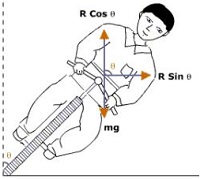CBSE 11TH PHYSICS - Online Test
Q1. The mass of a box measured by a grocer’s balance is 2.300 kg. Two gold pieces of masses 20.15 g and 20.17 g are added to the box. What is the difference in the masses of the pieces to correct significant figures?
Answer : Option D
Explaination / Solution:
Difference in masses = 20.17 – 20.15 = 0.02 g
In subtraction, the final result should retain as many decimal places as there are in the number with the least decimal places.
Q2. The period of a simple pendulum is doubled when
Answer : Option C
Explaination / Solution:
No Explaination.
Q3. A jet lands on an aircraft carrier at 30 m/s. It stops in 2.0 s? What is the displacement of the plane in m while it is stopping?
Answer : Option C
Explaination / Solution:
Initial velocity u = 30 m/s
As it stop so final velocity v = 0 m/s
Time t = 2 s
Distance covered = s
We know,
s =
=> s = 30 m
Q4. When a wave undergoes reflection at rarer medium then it undergoes a phase difference of
Answer : Option C
Explaination / Solution:
No Explaination.
Q5. The reason why cyclists bank when taking a sharp turn is
Answer : Option A
Explaination / Solution:
In order to take a safe turn, the cyclist has to bend a little from his vertical position. In this case, a component of the reaction provides the required centripetal force.
If q is angle made by the cyclist with the vertical then
Dividing (2) by (1), we get
=>
In actual practice, the value of q is slightly less because the force of friction also contributes towards the centripetal force.
Q6. Four identical hollow cylindrical columns of mild steel support a big structure of mass 50,000 kg. The inner and outer radii of each column are 30 and 60 cm respectively. Assuming the load distribution to be uniform, calculate the compression strain of each column. . Take Young's modulus of steel as 20 Pa
Answer : Option C
Explaination / Solution:
No Explaination.
Q7. A water heater is operated by solar power. If the solar collector has an area of 6.00 and the power delivered by sunlight is 550 W/ , how long does it take to increase the temperature of 1.00 of water from 20.0C to 60.0C?
Answer : Option D
Explaination / Solution:
Q8. Figure shows the position-time graph of a particle of mass 4 kg. What is the impulse at t = 0 and t = 4 s ? (Consider one-dimensional motion only)


Answer : Option D
Explaination / Solution:
Initial velocity , between t= 0s and t=4s, the particle has a constant velocity,
therefore slope of OA is
At t= 0,Impulse=Change in momentum
=
At t= 4s, initial velocity is 3/4 m/s,
So, the Impulse =
Q9. A bolt of mass 0.3 kg falls from the ceiling of an elevator moving down with an uniform speed of 7 m/s. It hits the floor of the elevator (length of the elevator = 3 m) and does not rebound. What is the heat produced by the impact?
Answer : Option B
Explaination / Solution:
Whole of the potential energy of bolt converted in to heat energy
heat produced by the impact = mgh =0.3×9.8×3=8.82J
Q10. Weak Nuclear Force
Answer : Option A
Explaination / Solution:
The weak nuclear force stops a neutron from decaying into a proton and an electron. When this happens, an electron leaves the atom. This is known as beta decay.

